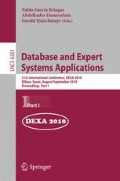Abstract
This paper seeks to improve usability and semantics of complex decision support based on multiple criteria and data envelopment analysis using the profile distance method. We recognize the need of decision making practice for more intuitive and understandable decision support in complex and comprehensive settings by proposing three areas for improvement. We suggest a more meaningful indicator of organizational fit, an advanced and dynamic multi-dimensional visualization, and embed support for weight estimation with pairwise comparisons into the method. The methodological advancements are shortly illustrated for an Information System selection problem.
Access this chapter
Tax calculation will be finalised at checkout
Purchases are for personal use only
Preview
Unable to display preview. Download preview PDF.
References
Bernroider, E., Stix, V.: Profile distance method: a multi-attribute decision making approach for information system investments. Decis. Support Syst. 42(2), 988–998 (2006)
Gunasekaran, A., Ngai, E., McGaughey, R.: Information technology and systems justification: A review for research and applications. European Journal of Operational Research (173), 957–983 (2006)
Bernroider, E., Obwegeser, N., Stix, V.: Introducing complex decision models to the decision maker with computer software - the profile distance method. In: Proceedings of the Knowledge Generation, Communication and Management (KGCM 2009), pp. 68–72 (2009)
Saaty, T., Air Force Office Of Scientific Researchbolling AFB DC: Optimization by the Analytic Hierarchy Process (1979)
Charnes, A., Cooper, W.W., Rhodes, E.: Measuring the efficiency of decision making units. European Journal of Operational Research 2, 429–444 (1978)
Cooper, W., Seiford, L., Tone, K.: Data envelopment analysis. Springer, Heidelberg (2000)
Cook, W.D., Seiford, L.M.: Data envelopment analysis (dea)–thirty years on. European Journal of Operational Research 192, 1–17 (2008)
Yoon, K.P., Hwang, C.L.: Multiple Attribute Decision Making: An Introduction. Sage University Paper series on Quantitative Applications in, CA. the Social Sciences. Sage Publications, Thousand Oaks (1995)
Belton, V., Vickers, S.P.: Demystifying DEA-a visual interactive approach based on multiple criteria analysis. Journal of the Operational research Society, 883–896 (1993)
Korhonen, P., Laakso, J.: A visual interactive method for solving the multiple criteria problem. European Journal of Operational Research 24(2), 277–287 (1986)
Deng, H.: Multicriteria analysis with fuzzy pairwise comparison. International Journal of Approximate Reasoning 21(3), 215–231 (1999)
Barzilai, J.: Deriving weights from pairwise comparison matrices. Journal of the operational research society 48(12), 1226–1232 (1997)
Saaty, T.: Decision making with the analytic hierarchy process. International Journal of Services Sciences 1(1), 83–98 (2008)
Saaty, T., Bennett, J.: A theory of analytical hierarchies applied to political candidacy. Behavioral Science 22(4) (1977)
Barzilai, J., Cook, W., Golany, B.: Consistent weights for judgements matrices of the relative importance of alternatives. Operations Research Letters 6(3), 131–134 (1987)
Saaty, T.: Decision-making with the AHP: Why is the principal eigenvector necessary. European Journal of Operational Research 145(1), 85–91 (2003)
Allen, R., Athanassopoulos, A., Dyson, R., Thanassoulis, E.: Weights restrictions and value judgements in data envelopment analysis: evolution, development and future directions. Annals of Operations Research 73, 13–34 (1997)
Author information
Authors and Affiliations
Editor information
Editors and Affiliations
Rights and permissions
Copyright information
© 2010 Springer-Verlag Berlin Heidelberg
About this paper
Cite this paper
Bernroider, E., Obwegeser, N., Stix, V. (2010). The Profile Distance Method: Towards More Intuitive Multiple Criteria Decision Making in Information Systems. In: Bringas, P.G., Hameurlain, A., Quirchmayr, G. (eds) Database and Expert Systems Applications. DEXA 2010. Lecture Notes in Computer Science, vol 6261. Springer, Berlin, Heidelberg. https://doi.org/10.1007/978-3-642-15364-8_16
Download citation
DOI: https://doi.org/10.1007/978-3-642-15364-8_16
Publisher Name: Springer, Berlin, Heidelberg
Print ISBN: 978-3-642-15363-1
Online ISBN: 978-3-642-15364-8
eBook Packages: Computer ScienceComputer Science (R0)

